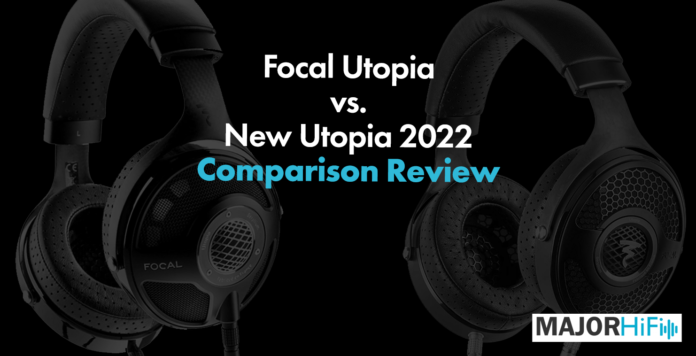The Focal Utopia has been one of the pinnacles of premium open-back headphones since its launch. An endgame headphone for many audiophiles. Although the Utopia is highly regarded as one of the best open-back headphones, over the years some have picked out some flaws in its build. Now in 2022, Focal has put out a new version of the Utopia that looks to improve upon its shortcomings and make the Utopia the best headphone it can be. I’ve listened to the old and new versions, and with some of these improvements come different profiles of sound that one might prefer over the other.
What You Get
| Utopia | Utopia 2022 |
|
|
Look and Feel
With Focal, you can never go wrong with their standard for build quality. The two headphones have different styles, but ultimately they use the same sturdy frame. Aesthetically, these are different headphones. With the new Utopia, Focal brings a honeycomb-styled speaker grille. It takes its appearance more from its Clear MG model than any of its other headphones. I think in this case, I actually prefer the original design of the Utopia. I find it more exceptional than the new version’s more familiar design. Comfort-wise, both Utopias seem to have a similar fit. Both models had the same amount of combined pressure and ventilation that makes these headphones satisfying to wear for many hours.
Design
Focal makes some adjustments on the inside as well as the outside. They stick with the Utopia’s Beryllium driver and add a new voice coil for the 2022 version. This addition looks to improve the durability of the driver while also keeping the Utopia relatively lightweight with its aluminum material. I’ve heard this was a sometimes critical issue with the original Utopia, so the 2022 version is seen as a necessary revision. However, these new components shape the output differently.
Soundstage
No matter what version of the Utopia you might be listening to, the soundstage is bound to impress you. While both headphones share an unrivaled standard for width and accurate imaging, the spatial appearance of the sound has different approaches to clarity. For instance, the original Utopia has more extended width to it, I think the new Utopia adds even more dimension to the performances. Each element of the mix is individualized in a closer but holographic space. Not entirely 3D, but closer to it than the original Utopia for sure. This doesn’t hinder accuracy, rather it increases immersion in your tracks. It reveals more complexities to the instruments and vocals in a non-linear and less clinical way. If you prefer a flatter image with the same level of clarity and separation, the original Utopia still works wonderfully. The new Utopia enhances that experience by opening up in a more dome-like fashion.
Low End
Both Utopia’s do an exceptional job delivering clear and fast bass with a ton of resolve. Their timbres are similar in that both Utopias have a precise impact that is tight in its coloration and expansive in its stage. While the bass gets a lot of room to perform all the rich details it is capable of, it is also clinical in its response. The New Utopia has a slightly warmer texture to its bass, with more feeling to its sub-bass as well. With that, both Utopias are still the most similar in their lows.
Mids
The Utopia’s similarities extend partially into the midrange. They both have a spacious and dynamic response throughout, with the new Utopia getting slightly elevated in some areas. Even though the original Utopia is still lively and detailed with its vocals and instrumentals, the new Utopia goes a step further with enhanced resolution. I felt like its sound elements had a bit more personality. I didn’t think you could get much clearer than the original Utopia, but the new Utopia just seems to have the advantage. This is mainly due to its higher transparency. Especially when it comes to the upper midrange, the performance gets to feel even more realistic. On the flip side, I can see not everyone likes this hyper-detailed response. The original Utopia also brought a similar level of fidelity, but with a less metallic glow. It was more intimate, and that isn’t the profile the new Utopia goes for.
Highs
I enjoyed the treble of both Utopias for very different reasons. Two different textures are given to the Utopias. The original has a fine airiness to it, while the new Utopia has a crisper shine. What it really comes down to is just how much treble you prefer. For some, the new Utopia might feel too sharp in some areas, while the old Utopia might be too unenergetic. I love airy highs, but I also appreciate some bite as well. Both Utopias work with what they’re going for, and it is bound to satisfy most listeners’ treble taste.
Summary
Choosing between the old and new Utopia is a tough one. These are two headphones you really need to hear yourselves to be able to decide which one is really the right version for you. To my ears, there is a clear distinction between the two, and I like certain elements about one that the other doesn’t have. For instance, I much preferred the treble of the new Utopia to the original, while I preferred the original’s less clinical midrange. The increased price of the new Utopia is also a factor. If you’re worried about long-term value, then the new Utopia might be your best option. If you prefer the sound signature of the original, then I don’t think spending the extra money on the new Utopia is the right decision. No matter which version you end up going for, both Utopia headphones still have their place and will continue to be a standard for excellence.
The Focal Utopia and Utopia 2022 are available at Audio46.
MAJORHIFI may receive commissions from retail offers.








